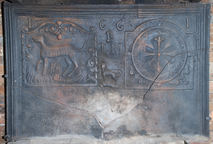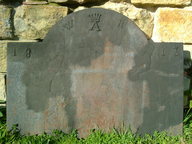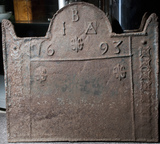-
1231
Description: Arched rectangular shape; ovolo-moulded edging; shield, Garter, crowned helm and mantling of the English royal arms to 1603 with crowned lion and griffon supporters standing on separate rectangular cartouches containing the word 'ANNO' and the date '1662'; above the mantling are the initials 'I R'
Notes: The date appears to have been altered from 1602. The initials 'I R' for Jacobus Rex (James I of England) are inappropriate for the date in both its original and its altered form; also the griffon supporter on the sinister side is incorrect, a dragon being correct for the arms of Elizabeth I in 1602. There is a vertical plankline left of centre.
Inscription: I R / HONI SOIT QVI MAL I PENSE / ANNO 1662
Arms: English Tudor royal
- Decoration tags:
- rounded arched (shape)
- ovolo (edging)
- whole carved pattern
- individual letters
- planklines
- heraldic
- armorial
- royal
- text
Manufactured: in 1662 possibly in the Ardennes area of Belgium.
Current location: Rijksmuseum, Museumstraat, Amsterdam South, North Holland, Netherlands.
Museum number: BK-NM-10837 (part of the Rijksmuseum museum group)
-
937
Description: Arched rectangular shape; gadrooned edging (top and sides); initials, in separate stamps, at top of arch; date probably in separate stamps, below, split by spindle; spindle used as a stamp repeated three times, one between date and initial stamps, the other two below to left and right.
Notes: Makes use of the same backing board as other firebacks in this series, and the same three spindles but with other initials; it may originate in the Cuckfield area of Sussex, where most examples have been noted; illustration from Harper (1906). Previously at Riddens (now West Riddens) Farm, Ansty, near Cuckfield, Sussex.
Inscription: S WC / 16 22
- Decoration tags:
- rectangular with round arch (shape)
- gadrooned (edging)
- simple stamps
- individual letters
- individual numbers
- text
- objects
Manufactured: in 1622 possibly at Cuckfield Furnace in the Weald area of England.
Current location: not known.
Citation: Harper, C. G., 1906, The Brighton Road (London, Chapman & Hall), p. 391.
- Attached to series:
- Spindle series
- Spindle/distaff firebacks
-
13
Description: Rectangular; composite: complex (cavetto/cyma recta/ovolo) moulded edging (top and sides), derived from domestic carpentry; two firebacks used as patterns: on the left, rectangular with mirrored floriate scrolled top, simulated overlapping tile edging at sides, with fillet bottom edge, a mythical salamander in the form of a dog with an arrow-shaped tongue, standing among flames, a stapled scroll inside the left and right edges; on the right, arched rectangular with fillet edging indented on the inner side, surrounding a circular clock face with Roman numerals, each interspaced with a bead, and a button outside each quarter, a triangular design of swirled foliage in each bottom spandrel; initials in triad between firebacks; below, stamp formed of a talbot statant guardant upon a wreath; date split: ‘1’s in top corners, ‘6’s above initials; bottom third of fireback plain.
Notes: The talbot crest, which in this instance has been over pressed and shows the shape of the backing, is seen on other firebacks indicating a common source; the 'salamander' fireback (see no. 851) is one of the Stapled Scroll series; composite firebacks (where the impression of one or more other firebacks are used as part of the decoration) are uncommon in England but less so in France.
Inscription: 16 61 / IBM [triad]
- Decoration tags:
- rectangular (shape)
- complex, furniture-derived (edging)
- composite
- individual letters
- individual numbers
- heraldic
- mythological
- text
- animals
- objects
Manufactured: in 1661 in the Weald area of England.
Current location: in private hands, Ardingly, West Sussex, England.
- Attached to series:
- Composite firebacks
- Talbot crest series
-
14
Description: Arched rectangular shape; plain plate. Crowned capital ‘A’ between ‘W’ and ‘R’; divided date at top extremities of plate; single six-pointed star below ‘A’.
Notes: Earl’s coronet denotes the Earl of Ashburnham, furnace owner; ‘WR’ denotes William Rummins, furnace founder; 1813 - the furnace was blown out for the last time in late February 1813. Similar to, but narrower than the fireback at Church Farm, Penhurst (in private hands), and uses the same cipher and numbers. One of a small series of firebacks cast in the early-19th century for farms on the Ashburnham estate; this example was formerly at Great Sprays Farm, Penhurst.
Inscription: W A R / 18 * 13
- Decoration tags:
- rectangular with round arch (shape)
- none (edging)
- carved stamps
- individual letters
- individual numbers
- heraldic
- text
- objects
Manufactured: in 1813 at Ashburnham Furnace in the Weald area of England.
Current location: in private hands, Ashburnham, East Sussex, England.
- Attached to series:
- Ashburnham late series
-
844
Description: Arched rectangular central panel; fillet edging; pictorial scene of a cloaked figure, to the right, tempting a dog, to the left, with a tasty morsel; behind are the outlines of a door and window; arched rectangular border with fillet edging, the date along the bottom; down each side, a floral festoon; over the arch, the inscription, the initials split between each side of the main inscription; on top, floral scrolls.
Notes: The inscription translates as 'loyalty above gifts'; some castings omit the initials, NL, indicating that they were a subsequent addition. The illustration is derived from 'The thief and the dog', one of a series of engravings of Aesop's Fables by Wenceslaus Hollar.
Copies of this fireback are known.
Inscription: N / FIDES DONA SUPERAT / L // 1696
- Decoration tags:
- 'Dutch' (shape)
- fillet (edging)
- whole carved pattern
- individual letters
- planklines
- pictorial
- allegorical
- text
- animals
- humans
Manufactured: in 1696 possibly in the Siegerland area of Germany.
Current location: English Heritage Store, Atcham Business Park, Atcham, Shropshire, England.
Museum number: EH ASC 4491 (part of the English Heritage museum group)
- Attached to series:
- 'Dutch' 1696 NL series
-
603
Description: Arched rectangular shaped, the arch linked to the rectangle by cavetto curves; cavetto edging ending in two opposed spirals at top; initials below spirals; date below initials; otherwise plain.
Notes: Probably cast from a carved, edged board, with the initials and date added separately. A copy.
Copies of this fireback are known.
Inscription: IH / 1678
- Decoration tags:
- rectangular with round arch (shape)
- cavetto (edging)
- individual letters
- individual numbers
- text
Manufactured: in 1678 in the Weald area of England.
Current location: Banbury, Oxfordshire, England.
- Attached to series:
- Small arch series
-
200
Description: Composite; rectangular with semi-circular arches in middle (large) and ends (small) of top edge; rope on all edges except bottom; central panel effectively comprises an arched fireback form with Tudor royal arms (temp. Elizabeth I) with date above, and, below, letters G M, made from rope with fleur de lys terminals between two coronets surmounted by lions; below this are fronds with roses. On either side of this panel are placed the Anne Forster inscription panels; above each of these is a rose and crown with lion and dragon supporters, beneath which are three fleurs de lys. Along the base of the inscription panels and the central panel are single rows of ‘grape bunch’ shapes, beneath which are repeated trailing vine decoration from impressed wooden strips across the entire width of the fireback; 35 in all.
Notes: Formerly at Baynard's Park, Ewhurst, Surrey; GM probably refers to Sir George More, who built Baynards Park after buying the estate in 1587, and who moved to Loseley in 1604. The central coat of arms has been noted on two other firebacks, dated 1588 (no. 41) and 1595 (no. 482). The rose and crown stamps have been noted on a fireback in Haslemere Museum, and on examples illustrated by Lower (all of which bear the date 1582 and the initials IA; e.g. no. 107 or no. 472). The association of these stamps and the particular form of rope lettering, with the Anne Forster inscription and the ‘grape bunch’ shapes, both of which have been linked with other stamps from Pounsley furnace, suggests that they, too, were part of the stock of those works.
Inscription: 15 93 / GM / HER : LIETH : ANE : FORST/ R : DAVGHTER : AND : / HEYR : TO : THOMAS : / GAYNSFORD : ESQVIER / DECEASED : XVIII : OF: / IANVARI : 1591 : LEAVYNG / BEHIND : HER II : SONES : / AND : V : DAVGHTERS [twice]
Arms: Tudor royal
- Decoration tags:
- rectangular with three arches (shape)
- rope (edging)
- simple stamps
- carved stamps
- carved pattern panels
- individual letters
- individual numbers
- planklines
- heraldic
- armorial
- royal
- text
Manufactured: in 1593 possibly at Pounsley Furnace, Framfield in the Weald area of England.
Current location: not known.
Citation: Manning, O. & Bray, W., 1809, History of Surrey Vol. II (London, John White), p. 369n.
Citation: Ogilvy, J. S., 1914, A Pilgrimage in Surrey, vol. 2 (London, G. Routledge & Sons), p. 8.
-
201
Description: Rectangular; moulded fillet edging on top and sides; TCI, also arranged symmetrically, in a widely spaced triad; below, symmetrical layout of central rose and crown between two concentric roundels, with two fleurs-de-lys outside.
Notes: The style of rose and crown is similar to that used in gun founding in the Tudor period, suggesting that the furnace that was the source of this fireback may have been used for that purpose. Formerly at Baynards Park, Cranleigh, Surrey.
Inscription: 16 T C I [triad] 70
- Decoration tags:
- rectangular (shape)
- complex, furniture-derived (edging)
- carved stamps
- individual letters
- individual numbers
- heraldic
- royal
- text
Manufactured: in 1670 in the Weald area of England.
Current location: not known.
- Attached to series:
- 1660s-90s Wealden series
-
966
Description: Arched rectangular shape; ovolo moulded edging; date in arch; below arch two parallel, vertical straps, each with a buckle at the top; initials left and right of centre; roughly symmetrical arrangement of four stamps repeated: rectangular stamp with deer three times down centre, one outside each buckle and one beyond each strap end; circular food mould stamp outside centre of each strap, beyond stag stamp outside buckle and at edge beyond strap end; 'rabbit' stamp at edge beyond food mould stamp outside each buckle and outside each strap end; rectangular stamp with 'dog' outside each initial and six times below strap ends.
Notes: The buckles suggest a connection with the Pelham family; the initials may relate to Sir Thomas Pelham, Bt. (1597-1654) who owned and operated ironworks at Waldron in Sussex. From the drawing the seven 'deer' stamps appear to be the same as those seen on two other examples of this fireback. The food mould stamp (centre left and right) appears to be one seen repeated on at least one other fireback. Drawing of a fireback at Huggetts Farm, Waldron, Sussex, by Edward Hughes, of Heathfield, Sussex; J. Starkie Gardner collection, Victoria & Albert Museum, Archive of Art and Design (AAD/2014/8).
Inscription: 1642 / T P
- Decoration tags:
- rectangular with round arch (shape)
- ovolo (edging)
- carved stamps
- whole carved pattern
- individual letters
- text
- animals
- objects
Manufactured: in the mid-17th century probably at Waldron Furnace in the Weald area of England.
Current location: not known.
Citation: Gardner, J. S., 1898, 'Iron Casting in the Weald', Archaeologia, 56, 1, pp. 133-164.
- Attached to series:
- 1642 Pelham series
- Pelham family firebacks
- Food mould stamp firebacks
-
1142
Description: Arched rectangular shape with quadrant extensions on top corners; twisted rope edging (top and sides); vertical rope line parallel to each side, forming two separate side panels; horizontal rope line joined to vertical lines enclosing the following: inside arch, initials IBA in triad; below initials, double fleur-de-lys stamp between split date; below horizontal line, a double fleur stamp in each top corner of central lower panel; in each side panel, a single bead above a vertical sequence of squared cross stamps repeated eight times.
Notes: The distinctive squared cross and fleur stamps are seen on other firebacks; the initials in triad may relate to a husband and wife. A taller variant of the same fireback is at Northgate House, Warwick. Mendip Auctions, Binegar, Somerset, 7 Sep 2019, lot 374.
Inscription: IBA [triad] / 16 93
- Decoration tags:
- rectangular with round arch (shape)
- rope (edging)
- simple stamps
- carved stamps
- individual letters
- individual numbers
- objects
Manufactured: in 1693 in the Forest of Dean area of England.
Current location: not known.
- Attached to series:
- Newent area group
- Square cross Dean series 2
- Fleur-de-lys firebacks

.jpg)







